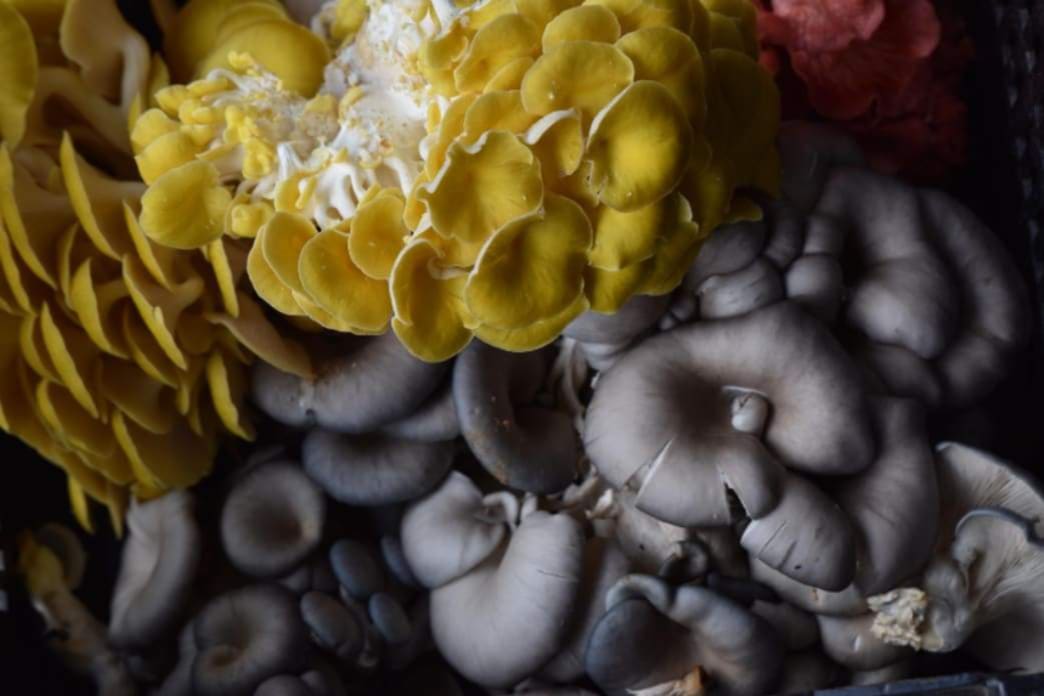We are looking at four major oyster mushroom growing problems, including why they happen and how to address them for bigger & better oyster mushroom yields
Today we are considering some of the oyster mushroom growing problems that can be encountered if some of the main parameters are off during the growing process.
Before we get to the information on these potential oyster mushroom growing problems, let’s take a look at some info on the background of oyster mushroom growing.
Understanding oyster mushroom growing
Oyster mushrooms grow extremely fast and aggressively. They require very little in terms of fruiting strategy. They display distinct morphological characteristics when a fruiting condition is not to their liking. This makes oysters suitable for beginners and mushroom farmers with low-tech equipment. Oyster mushroom spawn is readily available as grain or sawdust throughout the United States. This is a valuable resource because the mushroom farmer does not have to dedicate the time and resources necessary to create a sterile lab.
Certain strains of oyster mushrooms are abundant fruiters giving a good yield compared to labor input. They fruit in clusters making it easy to harvest and store. Oyster mushrooms tend to be fragile which can create some difficulty in packaging and selling.
The storability and fragility of oysters can be altered by changing the harvest stage but in general oyster mushroom are more fragile than shiitakes or any of the button mushrooms. This gives an advantage to the local producer, by minimizing the handling of the mushroom. The freshness and quality of locally produced oyster mushrooms can be far superior to what is found in most grocery stores.
The main parameters to consider if you are experiencing oyster mushroom growing problems
Oyster mushroom growing problems associated with lighting: Lighting should be similar to lighting found in a house, and LEDs or fluorescents work well for lighting. A cycle of 18 hours of light with 6 hours of darkness is perfect for the fruiting of oyster mushrooms. If the lighting is not enough, the mushrooms will have long stems and little caps as though they are growing in search of light, similar to what plants do in response to insufficient light.
Oyster mushroom growing problems associated with humidity: In order to fruit, mushrooms must have a moist environment to fruit into. Humidity should be kept between 80-90% depending on the stage of development the mushroom is in. To initiate pinning, a humidity level close to 90% is necessary. During fruit body development a lower humidity can be tolerated.
The tricky part of humidification is getting the air to be humid without directly spraying the mushrooms with water. Mushrooms act as sponges, sucking up any liquids they touch. If water is constantly being sprayed or poured onto them they will turn into a soggy puddle.
Using high pressure atomizing misters is the best option for creating the ideal environment for humidity. There are many different options for misters depending on a growers budget. Several good options with varying cost are home humidifiers, ultrasonic misters, hydrofogger, aquafogger, carbonator pumps and atomizing nozzles, or watering the floor and walls several times a day.
Oyster mushroom growing problems associated with temperature: The third environmental condition to be aware of is temperature. Most oyster mushrooms fruit best in the mid 60s. To maximize yields the temperature should be maintained between 62-68 degrees Fahrenheit. This is very difficult and costly to do. Some growers try to shift to warm weather-loving strains rather than try to control the temperature but when it is 95 outside, the mushrooms will not fruit well. Heating and cooling also typically dehumidify the air, drying it out so extra humidification is needed when using equipment to modify temperature.
Oyster mushroom growing problems associated with CO2 levels: Once these three parameters are modified and brought into the ideal range, the CO2 levels must be monitored. Like people, mushrooms breathe in oxygen and emit CO2. If the mushrooms are in an enclosed room it only takes about 10 minutes before the CO2 levels become too high for proper fruiting.
To address the build up of CO2 it is recommended that all of the air in the grow room is exchanged at least every 10 minutes. With oysters, the more fresh air the better. If CO2 is too high, the mushrooms will have long stems and little caps, and at levels above 1200 PPM fruiting can be inhibited. This last part makes controlling the previous three parameters very difficult because all of the air in the fruiting room must be changed out every 10 minutes. A constant conditioning of humidity and temperature is necessary for healthy and productive mushroom fruiting.
Getting started with oyster mushrooms
If you want to grow oyster mushrooms at home, we have grain spawn, sawdust spawn, and plug spawn available to you in a variety of different oyster mushroom species. Check out all of your spawn options on this page now.
We also have oyster mushroom growing kits, which lead to the quickest harvests. If you are new to growing oyster mushrooms, we highly recommend the blue oyster mushroom growing kit as these kits produce quickly!

